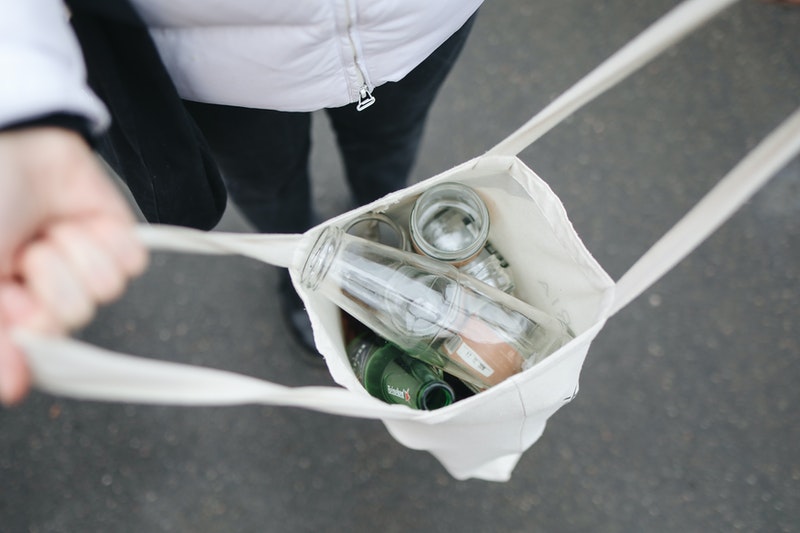1. Start Using Reusable Products
Recycling is undoubtedly one of the best ways to limit the trash that finds its way to landfills in America. However, just a paltry 23 percent of plastic bottles are ever recycled in the U.S. Unfortunately, when those bottles sit in landfills, it could take up to several centuries before they decompose fully.
So, always use reusable containers whenever possible. Here are a few ideas on how to do just that and the potential impact this may have:
– Instead of using plastic shopping bags that can take decades to decompose in a landfill, use reusable fabric/canvas shopping bags.
– Replace plastic water bottles with reusable polythene or PVC water bottles that may actually help keep your beverages cool or hot for longer.
– Use reusable stainless steel, glassware, or silicone containers for storing your food and beverages instead of using Styrofoam containers or cups that may take over 500 years to decompose.
The best part, perhaps, is the money you will end up saving in the end. Instead of buying cups, water bottles, or paper plates once a week, you can purchase reusable options once and use them for years without issue.
2. Use Energy in a More Efficient Way
You may assume that using electricity in your home is a “clean” approach to powering your favorite appliances. While that might be true on your end, depending on whether you have a wind turbine or solar panels, the power plants that supply much of the electricity used in households are incredibly harmful to the environment.
This is due to the fact that they are a key source of SO2 and CO2, which is capable of damaging the ozone layer, contributing to global warming, and impact the local environment. It is for this reason you should play your part by reducing your energy consumption as much as you can. Here are a few ways to do exactly that:
– Turn on lights, appliances, and devices only when you are actually in the room
– Unplug major devices when not in use
– Whenever possible, replace hot water with cold water
– User larger loads in your washing machine and dishwasher
– Raise your thermostat in the summer and lower it in the winter
– When you replace/upgrade appliances, look for the “EnergyStar” label.
Such appliances may include refrigerators and freezers, dishwashers, TVs and entertainment devices, etc. Besides requiring significantly less energy to perform, energy-efficient appliances can help you significantly cut down on monthly energy bills
With regards to energy, it is not always possible to notice just how much you are racking your electricity bill through careless use of electricity. You can determine whether you are getting a good deal on your electricity using online resources such as EnergyBot and help you find a new provider to save a bit more money.
Atkins UK discuss building a career for a sustainable future.
3. Start Growing Your Own Food
Heading over to the grocery store to pick out a new batch of vegetables and fruits each week is incredibly convenient, but, it is important to remember that a lot goes into actually getting those products from the farm to the store.
It is actually estimated that the actual production of the foods might be responsible for as much as 25 percent of global greenhouse gas emissions. The question that you probably have is, how exactly is that possible?
First, these foods are actually grown using harmful fertilizers and pesticides. Machinery is also needed to plant, grow, and harvest the crops. Then, there are the toxic fuel emissions associated with the transportation of the vegetables to the store via trucks. Finally, you also need to consider the plastic bags and coverings used to keep the produce fresh until you buy them.
So, it makes perfect sense to start your own vegetable garden.
4. Limit Your Driving
Today, there are new emission guidelines for vehicles, but cars and trucks are still a key source of pollution in the atmosphere. In fact, each gallon of gasoline burned when a vehicle is being driven generates close to 9 grams of CO2. That’s one of the key reason why the ozone layer disintegrates a bit more with each passing year. CO2 is also very harmful to breathe in.
So, try limiting your driving whenever possible. You don’t really need to hop into your vehicle and drive just ¼ mile down the road to the grocery store. If a store or location is within walking distance, make every effort to walk. Alternatively, you can ride your bicycle or your scooter safely.
You should also look into carpooling with friends and family. It can be an excellent idea if biking or walking is simply not feasible, but it also does not make a lot of sense to take multiple vehicles to the same destination. You can cut down on emissions too.






